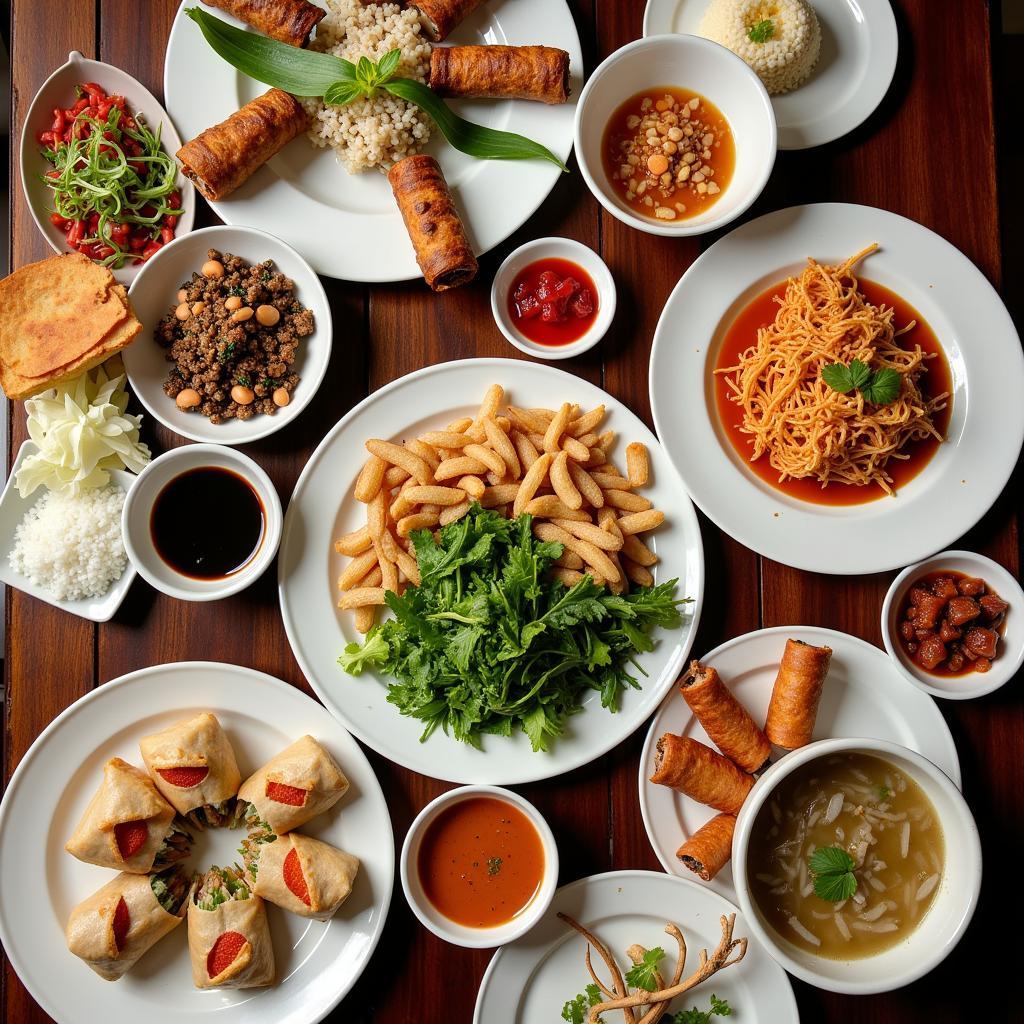Thai and Vietnamese food are two of the most popular cuisines in Southeast Asia. They’re both known for their fresh ingredients, bold flavors, and aromatic herbs. But what exactly makes them different?
 A colorful spread of Thai and Vietnamese dishes
A colorful spread of Thai and Vietnamese dishes
While it’s easy to confuse these vibrant culinary traditions, a closer look reveals unique characteristics that set them apart. From ingredients and cooking techniques to cultural influences and regional variations, understanding the Difference Between Thai And Vietnamese Food is a delicious journey for your taste buds.
Key Flavors: A Tale of Two Palates
One of the most noticeable differences between Thai and Vietnamese food lies in their flavor profiles. Thai cuisine is renowned for its intricate balance of sweet, sour, salty, and spicy. The use of chilies, lemongrass, galangal, and fish sauce creates a powerful symphony of taste that’s both exciting and harmonious.
Vietnamese food, on the other hand, leans towards a lighter, more delicate flavor profile. It emphasizes fresh herbs like mint, cilantro, and basil, along with tangy notes from lime juice and rice vinegar. While chili is used, it’s often offered as a condiment, allowing diners to customize their spice level.
Signature Ingredients: A Glimpse into Culinary Traditions
The geographical diversity of Thailand and Vietnam is reflected in their respective cuisines. Both countries boast an abundance of fresh produce, but their staple ingredients reveal subtle differences.
Coconut milk, for instance, is a cornerstone of Thai cooking, lending a rich, creamy texture to curries, soups, and desserts. It’s less common in Vietnamese cuisine, which favors lighter broths and sauces. Similarly, while both countries utilize fish sauce, it tends to be saltier and more pungent in Thai cuisine.
Rice, of course, is a staple in both culinary traditions. However, Thailand is known for its fragrant jasmine rice, while Vietnam prefers a slightly stickier variety.
Cooking Techniques: From Wok to Steam
The way food is prepared also plays a key role in differentiating Thai and Vietnamese cuisine. Thai cooking often involves high heat and quick stir-frying in a wok, resulting in dishes with smoky aromas and a delightful interplay of textures.
Vietnamese cuisine, however, often employs steaming and simmering as preferred cooking methods. This gentler approach preserves the fresh flavors of vegetables and herbs, resulting in lighter and often healthier dishes.
Cultural Influences: A Story on Every Plate
Food is an intrinsic part of any culture, and both Thai and Vietnamese cuisines have been shaped by centuries of history and tradition. Thai food, for instance, reflects influences from India, China, and neighboring Southeast Asian countries. This melting pot of culinary ideas is evident in dishes like Massaman curry, a rich and aromatic curry with Persian origins.
Vietnamese cuisine, while also influenced by China, has a distinct French flair. The French colonization period left its mark on Vietnamese cooking, evident in dishes like Banh Mi, a crusty baguette sandwich filled with savory meats and pickled vegetables.
Regional Variations: A Culinary Adventure
Just as there’s no single “Thai” or “Vietnamese” culture, there’s immense culinary diversity within each country.
Northern Thailand, for instance, is known for its use of fermented soybeans and bolder flavors, while Southern Thailand favors seafood and fiery curries. Similarly, Vietnamese cuisine varies significantly from North to South. Northern Vietnam features dishes with a more subtle flavor profile, while Southern Vietnam embraces sweeter and spicier notes.
Beyond the Basics: Exploring the Nuances
While we’ve explored some key differences, it’s important to remember that these are just starting points. The world of Thai and Vietnamese food is vast and endlessly fascinating. From street food stalls to fine dining restaurants, each region and even each chef brings their unique interpretation to these beloved cuisines.
So, the next time you find yourself craving the bold flavors of Southeast Asia, embrace the delicious differences between Thai and Vietnamese food. Let your taste buds embark on a culinary adventure, and discover the unique flavors and cultural stories that each cuisine has to offer.
FAQ
1. Is Thai food spicier than Vietnamese food?
Generally, yes. Thai cuisine typically incorporates more chili peppers and heat into its dishes. However, both cuisines offer a range of spice levels, and you can always adjust the heat to your preference.
2. What are some popular Thai dishes for beginners?
Pad Thai (stir-fried noodles), green curry, and mango sticky rice are great starting points for exploring Thai flavors.
3. What is the best way to experience Vietnamese food?
Seek out authentic Vietnamese restaurants or explore street food stalls for a true taste of the cuisine.
Need Help Navigating the World of Thai and Vietnamese Cuisine?
Contact us! We’re here to help you explore the delicious world of Southeast Asian flavors. Call us at 02437655121, email us at [email protected], or visit us at 3PGH+8R9, ĐT70A, thôn Trung, Bắc Từ Liêm, Hà Nội, Việt Nam. Our friendly team is available 24/7 to assist you.